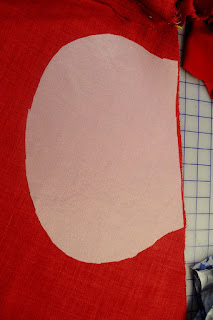I'm really interested in rotating darts at the moment and have been practicing by making simple tops. For the one I'm showing today , I opened up my DD bust dart in both the shoulder and center front areas. It's a simple process if you have the patience to make a copy of a pattern and to work methodically. There's quite a bit of cutting ,spreading, and taping involved. For more details if you want them, go here to Diana's Sewing Lessons.
For my top, I redrew my Surefit Designs sloper in a smaller size by going down a dot. With SFD, you use the bust dart size you need ( in my case a DD ) so there is no need for a Full Bust Adjustment but you make all your other adjustments, e.g. Rounded Upper back, and Sway back. I've found that there is no need for Narrow Shoulder adjustment and I only need a minimal Sloped Shoulder adjustment for this system.
Here is what my pattern front looks like before and after rotating the dart. For the designed top I lowered the neckline 5/8".


I added about 1 1/2 " to the width of the shoulder in addition to the spread where I opened the bust dart so I had to add the same to the back shoulder. I shirred the front to fit the new back shoulder
To know how much to gather the center front, measure the CF seam from neckline to hem before you open the dart. Once opened, the CF will spread. Gather the area where you spliced and spread until the center front seams are equal to the original measurement. (I hope that makes sense ! ) I should also say that you don't need as many slices as I made Probably one would be sufficient at the CF bust line.
I also moved half the waist darts in both front and back to the side seam instead of sewing a half dart. I wanted a slightly fitted silhouette. To do this, I traced the waist dart ,cut it in half lengthwise, then lay it on the side seams and trimmed that amount from both front and back.
Before I started my top , I used Sally Silhouette to design a top I thought would go well with last summer's fun palazzo pant. I gave the Sandra Betzina top to my DGD because it was too fitted for my taste.
I curved the CF seam at the bottom by using my Design Stylus.
I turned the hem under 5/8" in the front but for the back, I sewed a 1 1/2 " facing because I cut it a little too short
This photo is a little pale but it shows the shirring at the shoulders and CF where I opened the bust dart.
The back is just plain.
Here's an "action " shot taken at our Family get-together which we hosted.
Now as for the topper, this is what I planned to do.
I changed my mind when I started to draft the pattern and I don't love the result. I drew a complete front ( both sides ) and drew a line from the neckline to the opposite lower side.
Here is the " cardi"with this remodeled 10 year old dress that use to look like this .
and of course my wild and crazy palazzos. ( I admit the pics are quite washed out. I didn't pay attention to the settings !!)
I'm using my SFD sloper to check the fit of all the patterns I'm sewing up. It's a great fitting tool. For example I used it to check the fit on the pattern I used to make my reunion dress which I blogged here I was able to determine that I needed only a slight FBA and that I needed to narrow the shoulders a bit, etc.
If you're like me and are determined to make your clothes fit as well as possible, do give Surefit Designs a try. It isn't at all hard to use and it's a lot of fun to learn something new ,in my experience
Happy sewing from























































